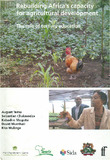The place of agroforestry in the rehabilitation and utilisation of semi-desert environments of northern Kenya

View/
Date
2004Author
Olukoye, GA
Wamicha, WN
van Eckert, M
Mwanje, ]I
Kinyamario, JI
Language
enMetadata
Show full item recordAbstract
Increasing destruction and degradation of the natural resource base in the sand-duned
landscapes of North Horr, Marsabit District, northern Kenya, are jeopardising efforts towards
sustainable economic development. The Gabbra nomads of the area live under
severe poverty conditions. Effo~s to assessand apply agroforestry practices towards the
rehabilitation and utilisation of the area's vast rangelands are at a formative stage. Tothis
end silvopastoral systems have been formulated designed to ensure continued provision
of fodder for livestock, improved soil fertility, provision of fuelwood, conservation of water
resources and land rehabilitation. Suitable technologies including semi-desert plants such
as Hyphaene coriacea for basketry and thatching of dwellings and Suaeda monoica for dry
season browsing by camel are possible candidates for further development. The potential
to domesticate wild plants for conservation purposes exists. Unfortunately direct planting
of trees on communal lands within the study area is low. This paper examines the dual
utilisation of agroforestry practices for land rehabilitation and enhancement of economic
production systems in North Horr dry lands. Some of the factors that have hindered the
effective application of agroforestry practices in the rehabilitation of the semi-desert environment
of North Horr are also discussed. It is concluded that by addressing some of these
factors and issues through community education programmes it would be possible to
provide an effective framework for increased community participation for sustainable landuse
management using suitable agroforestry techniques in semi-desert environments.
Citation
Rebuilding Africa's capacity for agriculture Development: the role of tertiary educationPublisher
World Agroforestry Centre
